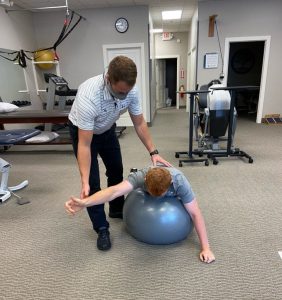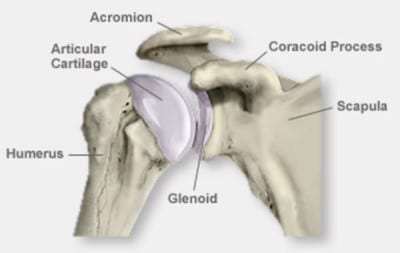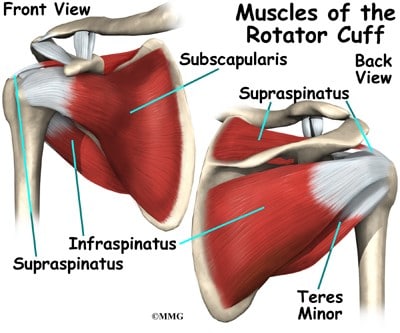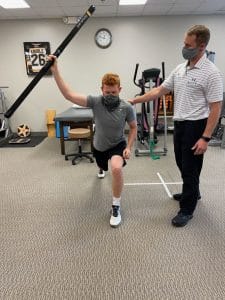Overhead Athlete Injury Prevention

Here at Hulst Jepsen Physical Therapy, we see a lot of overhead athletes who are recovering from an injury and looking to return to their sport. Who is considered to be an overhead athlete? This group includes (but not limited to) baseball, softball, soccer goalkeepers, quarterbacks, volleyball, swimmers, tennis, shotput/discus throwers, and CrossFit athletes. This is not just high-level athletes, but also weekend warriors and those who play these same sports recreationally. Some sports such as baseball, softball, and football use a more “short arm” throwing motion to accomplish the required task, compared to sports such as tennis, volleyball, and swimming that require a more “long arm” motion. This is why it is so important to train specifically for the sport you are participating in. As a former athlete I have developed a strong passion for working with overhead athletes to assist them with obtaining their goals. Full disclosure, my personal history is mostly in the realm of baseball so bear with me if many of my examples are related towards baseball. I apologize in advance…
The shoulder is a ball and socket joint, but the socket is not very deep. This allows for increased mobility in the shoulder, but doesn’t provide much boney stability because of this. The rotator cuff musculature and labrum provide the shoulder with its stability. If rotator cuff weakness is present or labrum injuries are present this can cause an imbalance of the congruency at the shoulder. This imbalance is what leads to shoulder pain in the form of tendonitis, rotator cuff tears, and labral tears. When this begins to occur, the athlete may also begin to have increased elbow pain as they try to compensate for their shoulder.

Often times training programs for overhead athletes incorporate many repetitive overhead activities that can actually cause irritation to these tissues if performed to frequently or incorrectly. This repetition along with sport related demands can lead to many of the common overuse injuries we see in the clinic including rotator cuff injuries, labrum tears, shoulder impingement, and UCL strains/tears. This is why it is so important to seek advice from a qualified medical professional prior to initiating a training routine to create a safe program with your specific sport and goals in mind.

Overhead athletic motions require extreme forces, including significant torque, placed on the shoulder, elbow, and wrist. Take the throwing motion in baseball for example. Throwing a baseball is the fastest movement of the body that has ever been recorded (Equivalent to arm spinning fully around 24 times a second during acceleration phase.) Did you know that the distraction force placed on the shoulder during a pitch is 1.5x the pitcher’s body weight?! It is incredible to me that our shoulder doesn’t dislocate every time we throw with that amount of force! Many people don’t realize that significant force generation occurs in the legs and trunk, not the arm. In baseball, roughly 50% of the energy created to accelerate the ball is created in the lower body. Roughly another 30% of the power is generated by the trunk. This means that while throwing a baseball the arm creates only about 20% of the overall force required for this movement. The true job of the arm is to dissipate all the force generated by the legs and trunk during the deceleration phase of the follow through motion in a safe and controlled manner to help prevent injury from occurring.
When there are lower body and core strength deficits present, a phenomenon known as catch-up has to occur in the arm. When throwing a baseball even a 20% decrease in combined trunk and lower body power generation causes a 34% increase in required output from the UE. This change more than doubles the normal power generation that should be provided by the arm causing a significant increase in arm injury risk. This is why it is SO important that overhead athletes take part in a regular strength and conditioning program that focus not just on the arm but also lower body and trunk strengthening/mobility exercises.

Often times, many of the youngest and most talented overhead athletes are at the highest risk of injury. This is because they throw harder/produce more force, participate on more teams throughout the year, and take less time off from the sport. This leads to these young athletes pushing through fatigue. There is a 36x increased risk of injury in youth pitchers that throw while fatigued. Fun fact: 70% of hall of fame pitchers are from North of the Mason Dixon Line. This is thought to be due to the decreased pitching frequency during their youth, which helps prolong their career.
This equation for injury risk in baseball/softball players is as follows: (Volume x Velocity)/Rest= Risk of Injury. In order to make this equation work in our favor we can increase the amount of rest or decrease the volume of training performed to help prevent injuries. I have yet to meet a throwing athlete that wants to decrease their velocity to make this equation work…
There has been a significant increase in the trend of sport specialization for athletes starting at a young age. This decreases both active and passive recovery time for these athletes between competition. If you meet the criteria for any one of the next three statements you meet the criteria for sport specialization. Participation in a sport throughout the year for greater than 8 months. Participation on more than one team for that sport in the same year. Getting private lessons/training for that sport. Keep in mind that just because the athlete plays more than one sport it does not mean they don’t specialize in a sport. Sport specialization increases the risk of injury as a youth athlete by 5X! These injuries at an early age can have a significant impact on the athlete as they continue to participate in sports throughout the rest of their life.
In order to prevent athletes from competing when fatigued we must do the following:
- Monitor frequency of training (pitch counts in baseball, laps for swimmers, number of hits for volleyball, number of serves for tennis, etc.)
- Take part in a good year-round strength and conditioning/Arm care program based on the needs of your particular sport.
- Listen to athletes who report any elbow or shoulder pain and rest these athletes to avoid further injury.
- Limit the frequency of performing the same activity to avoid overuse injuries (Limiting the frequency that pitchers play catcher in baseball/softball when not on the mound).
- Allowing for appropriate amount of time for recovery following participation in sport related tasks and training based on individual sport demands.
How can Physical Therapy Help?
- We are trained to screen for any mobility and strength deficits that may predispose an athlete to injuries that could be avoided.
- We work with the athlete to create an individualized mobility/strength program to improve these deficits and maximize full potential in the specific sport while also decreasing injury risk.
- We educate the athlete on proper body mechanics for their sport along with arm care strategies to help prevent injuries and promote improved career longevity.
- If you are currently experiencing pain with your specific sport we can identify the exact site of the injury and identify any underlying reasons why the pain is occurring to assist with getting back to pain-free play.
Here is a link to the thrower’s ten series video we have previously recorded for you to follow along with and start making strides toward reaching your goals. https://www.youtube.com/watch?v=S2e4SfiKsPM
At Hulst Jepsen Physical Therapy, there are many specialties and services that our healthcare providers are trained in that can help overhead athletes, both from a prevention and rehabilitation standpoint. We are here to help you stay healthy and offer our expert assistance to you in any way possible. Call one of our locations to schedule a free screening today.
